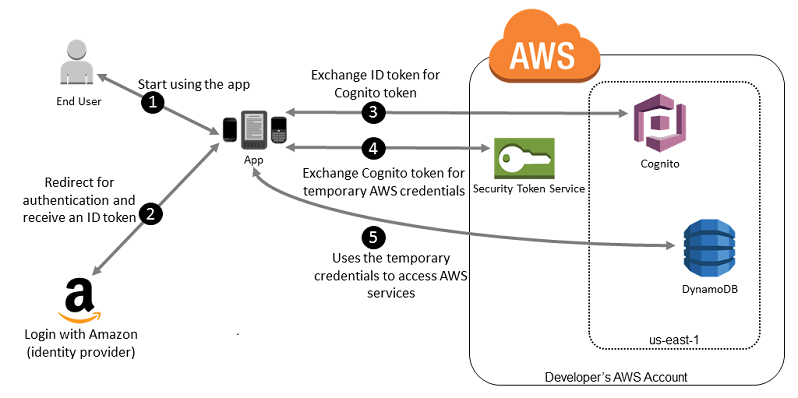Using Amazon Cognito for mobile apps
The preferred way to use OIDC federation is to use Amazon Cognito
To enable the mobile app to access her AWS resources, Adele first registers for a developer ID with her chosen IdPs. She also configures the application with each of these providers. In her AWS account that contains the Amazon S3 bucket and DynamoDB table for the game, Adele uses Amazon Cognito to create IAM roles that precisely define permissions that the game needs. If she is using an OIDC IdP, she also creates an IAM OIDC identity provider entity to establish trust between an Amazon Cognito identity pool in her AWS account and the IdP.
In the app's code, Adele calls the sign-in interface for the IdP that she configured previously. The IdP handles all the details of letting the user sign in, and the app gets an OAuth access token or OIDC ID token from the provider. Adele's app can trade this authentication information for a set of temporary security credentials that consist of an AWS access key ID, a secret access key, and a session token. The app can then use these credentials to access web services offered by AWS. The app is limited to the permissions that are defined in the role that it assumes.
The following figure shows a simplified flow for how this might work, using Login with Amazon as the IdP. For Step 2, the app can also use Facebook, Google, or any OIDC-compatible IdP, but that's not shown here.

-
A customer starts your app on a mobile device. The app asks the user to sign in.
-
The app uses Login with Amazon resources to accept the user's credentials.
-
The app uses the Amazon Cognito API operations
GetIdandGetCredentialsForIdentityto exchange the Login with Amazon ID token for an Amazon Cognito token. Amazon Cognito, which has been configured to trust your Login with Amazon project, generates a token that it exchanges for temporary session credentials with AWS STS. -
The app receives temporary security credentials from Amazon Cognito. Your app can also use the Basic (Classic) workflow in Amazon Cognito to retrieve tokens from AWS STS using
AssumeRoleWithWebIdentity. For more information, see Identity pools (federated identities) authentication flow in the Amazon Cognito Developer Guide. -
The temporary security credentials can be used by the app to access any AWS resources required by the app to operate. The role associated with the temporary security credentials and the assigned policies determines what can be accessed.
Use the following process to configure your app to use Amazon Cognito to authenticate users and give your app access to AWS resources. For specific steps to accomplish this scenario, consult the documentation for Amazon Cognito.
-
(Optional) Sign up as a developer with Login with Amazon, Facebook, Google, or any other OpenID Connect (OIDC)–compatible IdP and configure one or more apps with the provider. This step is optional because Amazon Cognito also supports unauthenticated (guest) access for your users.
-
Go to Amazon Cognito in the AWS Management Console
. Use the Amazon Cognito wizard to create an identity pool, which is a container that Amazon Cognito uses to keep end user identities organized for your apps. You can share identity pools between apps. When you set up an identity pool, Amazon Cognito creates one or two IAM roles (one for authenticated identities, and one for unauthenticated "guest" identities) that define permissions for Amazon Cognito users. -
Integrate AWS
Amplify with your app, and import the files required to use Amazon Cognito. -
Create an instance of the Amazon Cognito credentials provider, passing the identity pool ID, your AWS account number, and the Amazon Resource Name (ARN) of the roles that you associated with the identity pool. The Amazon Cognito wizard in the AWS Management Console provides sample code to help you get started.
-
When your app accesses an AWS resource, pass the credentials provider instance to the client object, which passes temporary security credentials to the client. The permissions for the credentials are based on the role or roles that you defined earlier.
For more information, see the following:
-
Sign in (Android)
in the AWS Amplify Framework Documentation. -
Sign in (iOS)
in the AWS Amplify Framework Documentation.